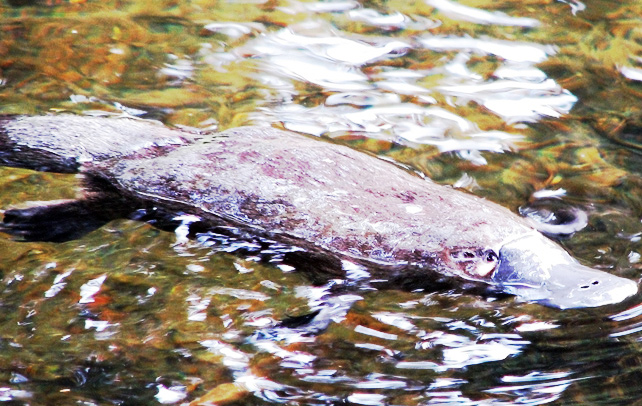Amazing Fun Facts About Platypus

The platypus was indeed God’s idea of having fun. Imagine him at work, taking the beak and feet of a duck, the tail of a beaver and the body and fur of an otter and through divine power bringing to life an oddity. However, that was not enough as ‘He’ was in a mood for some more mischief. So, ‘He’ didn’t bless it with any teeth, made the females lay eggs like a bird but nurse their young ones with milk like a mammal, and armed male with venomous spurs on the hind feet (probably to stun anyone who dares to laugh at this monstrosity). If that was not enough, ‘He’ equipped their beak with thousands of electroreceptor so that it could catch its foods without using the other sense organs. The result was the platypus, which ‘He’ released into the wilds of Eastern Australia and chose to baffle humanity for generations. After seeing this animal, anyone can be sure that the bat was just a rehearsal. If you want to know more on this enigmatic, hodgepodge quirk of nature, continue reading the interesting and amazing facts on platypus.
Fast Facts
Scientific Name: Ornithorhynchus anatinus
Type: Semi-aquatic mammal
Kingdom: Animalia
Phylum: Chordata
Class: Mammalia
Order: Monotremata
Family: Ornithorhynchidae
Genus: Ornithorhynchus
Origin: Eastern Australia and Tasmania
Diet: Crustaceans
Size: Males – 50 cm (20 in); Females – 43 cm (17 in)
Weight: 0.7 to 2.4 kg (1.5 to 5.3 lb)
Lifespan: 17 years in captivity and about 11 years in the wild
Habitat: Freshwater lakes and streams
Gestation Period: 1 month
Number Of Eggs: 1 to 2
Amazing Fun Facts About Platypus
- When European naturalists first encountered the platypus, they thought that it was a hoax. They believed that someone has sewn a duck’s bill and an otter’s tail into a beaver like animal.
- The name platypus is derived from the Greek word “platys” meaning broad and “pous” meaning foot because of its large webbed foot.
- The platypus is a warm blooded, egg laying mammal with webbed feet and fine, dense fur, which is waterproof and resembles that of a mole. Unlike other mammals, the platypus lays eggs, typically two eggs, which cling to the female’s fur on her belly.
- The female platypus has two ovaries, but only the left one is functional.
- The platypus is also a mammal that produces venom. However, only the males have the ability to do so. The animal injects the strong toxic venom from a spur on its hind foot and it is powerful enough to kill a small animal and cause severe pain to humans.
- The females do not suckle their babies, as they do not possess any nipples. Instead, they have two glands in their belly that secretes milk and it oozes into the mothers fur, which the babies slurp off.
- The platypus, apart from using its tail to paddle underwater, also uses it to store fats. About 50% of the animal’s body fat is stored in its tail.
- The fur of the platypus is denser than the polar bear and the river otter with about 800 hairs per square millimeter.
- The platypus is the only mammal to have extra bones in the shoulder girdle including an interclavicle.
- It uses its snout as a sensory organ to search for prey and its mouth is located under it.
- The platypus emits a growl that resembles a puppy.
- Its webbed feet and flat tail makes it an excellent swimmer. In fact, it is so graceful underwater that early sailors considered it to be the mermaid. When underwater, its eyes and ears are covered by folds of skin and the nostrils close tightly to prevent the water from entering. Therefore, the only way that it can locate prey is with its sensitive, rubbery and flexible gill, which has hundreds of receptors that respond to tiny electric currents. The platypus can remain underwater only for a minute or two.
- It feeds on insects, worms, larvae and small shellfish found at the bottom of the water source and hunts mostly at night. It does not feed underwater, storing its catch in cheek pouches and feeding only after reaching the surface. Since it does not have any teeth, it mashes its catch before swallowing. It also swallows bits of gravel to help it digest its food.
- On land, the platypus moves around awkwardly and walks on its knuckles to protect the webbing on its feet. To run, it retracts the webbing on its feet and exposes its nails.
- It lives near freshwater lakes and streams and uses its nails and feet to dig a burrow on the water edge. A borrow can be as long as 100 feet in length and most of the time there are two entrances/exits. It can spend as much as 17 hours a day resting inside a burrow.
- The female lays eggs after sealing herself in one of the chambers of the burrow. She lays about one or two eggs and holds them between her body and tail to keep warm. The eggs hatch in about ten days and the mother nurses the infants for three to four months, by which time they can swim on their own. The infants have teeth, which later fall off.









